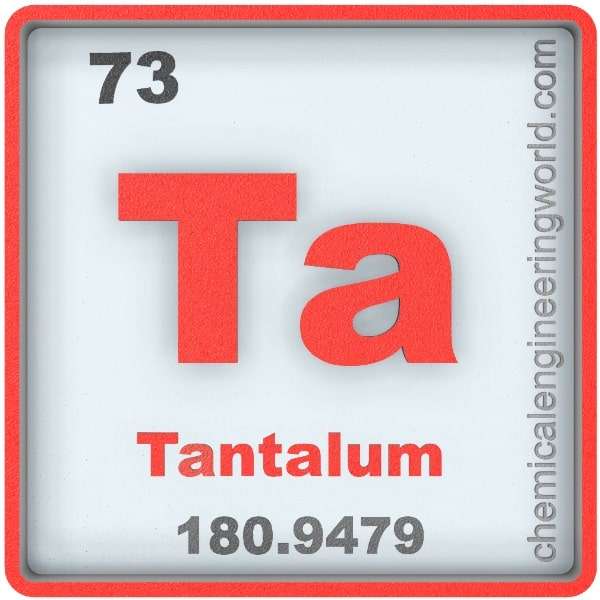Tantalum Element Properties and Information

Tantalum Element Properties and Information
Tantalum is 73th element on the periodic table. Elements are arranged in the periodic table on the basis of the atomic number. Atomic number is the number of protons in the nucleus of the atom. Tantalum has an atomic number of 73. It is located in the Group 5 and Period 6 of the periodic table of elements. It is denoted by ‘Ta’. Its name is derived from the Greek figure ‘King Tantalus’.
Anders Gustav Ekeberg is credited as the discoverer of Tantalum; he announced it as a new element in 1802. William Wollaston analysed it and reasoned that it is chemically very similar to Niobium which was discovered in 1801. The similarity between those elements is of such extent that there was often confusion in identifying which is which; also, their separation posed great difficulty in those days. The conclusive proof of them being separate elements only came after Heinrich Rose successfully separated tantalum and niobium in 1846. The separated elements were still impure and pure metal was obtained by Werner von Bolton in 1903. Tantalum occurs as a free element in nature although, only rarely, not in extractable quantities. It’s concentration in Earth’s crust in 1-2 ppm. It maily occurs in tantalite series; tantalite-Fe, tantalite-Mn, tantalite-Mg, etc. It is mainly extracted from columbite-tantalite mineral along with niobium and more heavy metals.
Physical Properties
- Tantalum is a hard & rare transition metal which has lustrous blue-gray appearance and is part of the group of refractory metals.
- The atomic mass of tantalum is 180.95.
- The melting point of tantalum is 2850°C.
- The boiling point of tantalum is 6000°C.
- The density of tantalum is 16690 in S.I. units at 20°C.
- Tantalum showcases high conductivity of heat and electricity.
- Tantalum exists in two phases; alpha crystalline & beta. The bulk tantalum exists in alpha phase with beta phase being present as thin films. The ordering of alpha phase is body-centered-cubic. The beta phase is meta-stable in nature and reverts to alpha phase at 750°C.
- Naturally occurring tantalum appears as two isotopes; tantalum-181 and tantalum-180m. The tantalum-181 is stable. Tantalum-180m is radioactive and amounts to even less than 0.1% of total tantalum. The ‘m’ indicates it is meta-stable.
Chemical Properties
- Tantalum compounds occur in oxidation states ranging from +3 to +5.
- Tantalum is resistant to attach done by most acids except those containing fluoride and sulphur trioxide.
- Tantalum exists only in +5 oxidation state in an aqueous solution.
Tantalum forms oxides, carbides, nitrides, sulphides, halides, and organometallic compounds.
Methods of Production
Hydrometallurgy: The ores are crushed and leached using hydrofluoric acid along with either hydrochloric acid or sulphuric acid. The tantalum and niobium fluoride complexes are then separated from rest of the other metals by solvent-extraction method by selecting a suitable solvent. The acid mixture obtained after that contains tantalum and niobium. The tantalum is separated from the niobium by reducing the ionic strength of the acid mixture, this action causes niobium to get dissolved in the acid. The solution is then neutralised using ammonia which yields hydrated tantalum oxide which is further calcined.
Relevance in Chemical and Related Industries
Alloys: Tantalum is combined with other metals to form alloys which are strong, very ductile, and have high melting point. Such alloys are used in variety of industries and machineries namely for; chemical process equipments, jet engine components, missile parts, heat exchangers, tanks, vessels, nuclear reactors, surgical instrument, medical implants, etc.
Relevance in Other Industries
- Electronics: Largest use of tantalum is in making electronic components, mainly; small volume efficient capacitors and also high-powered resistors.
- Camera lenses: Tantalum is used to make specific high-refractive index glass for camera lenses.
Health Effects on Exposure
Irritation: The inhalation, skin-contact, or ingestion of tantalum compounds or tantalum itself irritates the organs of contact
Effects on Surroundings
- Pollution: Release of tantalum compounds from industries, pollutes the environment.
References:
https://en.wikipedia.org/wiki/Tantalum
https://www.lenntech.com/periodic/elements/ta.htm
https://www.rsc.org/periodic-table/element/73/tantalum
































